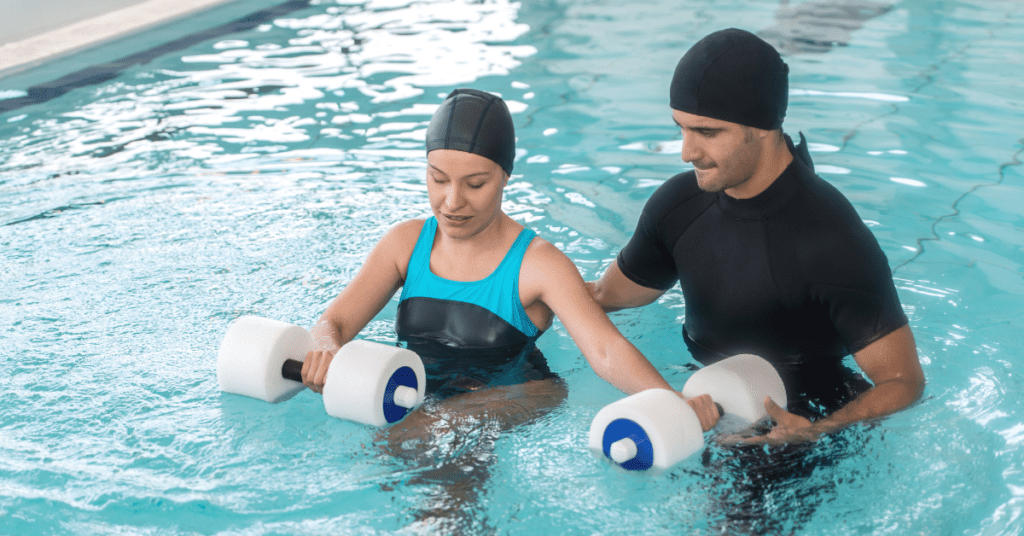
Guest Author: Ellie Martin
Physical therapy is good for rehabilitation. However, it can be straining on our muscles by the end of a session. Aquatic therapy is a way to help relax muscles while also providing the same benefits as land therapy. Aquatic therapy is described as a technique that uses water for resistance while doing the same form of exercises as physical therapy. According to Johns Hopkins Medicine, “Water can make exercise easier and less painful because it removes excessive forces on joints.”
I first started aquatic therapy when I was very young and learning to walk. I still experience the benefits of aquatic therapy as an adult because of the calming environment, and it takes away the fear of falling so you can focus more on the exercises.
Benefits and Limitations of Aquatic Therapy for Ataxia
Cleveland Clinic notes that aquatic therapy provides a comfortable, therapeutic way to gain strength and endurance for those who have difficulty exercising on land. Someone who has difficulty balancing on land may find it easier to balance in the water. Because of the decreased pressure on the joints, it serves as a gentle environment for exercise. Exercising in the water has great effects, including:
- Decreasing pain
- Being gentle on the body
- Providing low impact resistance movements for strengthening
One of the major advantages of this form of therapy is the buoyancy of the water. Buoyancy will help decrease the amount of weight which provides less stress on the joints. It may also help with balance and cause you to feel more relaxed while doing exercises. According to Physical Therapist Laura Inverarity, “Using resistance coupled with the water’s buoyancy allows a person to strengthen muscle groups with decreased joint stress that cannot be experienced on land.” The water also provides resistance while exercising, mimicking resistance bands.
In addition to the physical benefits of aquatic therapy for Ataxia, there are also positive impacts on your mental health. While in water, patients often feel a sense of calmness, which is good for our mental health. Hydroworx, a company that develops specialized aquatic therapy pools, states that, “stress relief has such a profound effect because it starts by soothing the body, which in turn helps soothe the mind.” When individuals can move better in the water, it makes them feel more confident. The water provides others with a chance to do the things that are frightening to do on land. In my opinion, I feel much safer in the water than on land.
While there are many benefits to aquatic therapy as a form of rehabilitation, it also has its limitations. Accessibility can be a problem, particularly in more rural areas. Not everyone has convenient access to pools or to specialized aquatic therapy centers, which does not make it an easy option for everyone. Additionally, the cost of therapy, availability of services, transportation, and scheduling difficulties can be prohibitive.
Nonetheless, aquatic therapy serves as a beneficial form of rehabilitation and exercise, offering a refreshing and enjoyable alternative for individuals with Ataxia and other neurological conditions. The buoyancy of water provides a supportive environment, reducing the impact on joints and promoting increased mobility, strength, and flexibility. Beyond the physical advantages, the sensory and calming effects of water contribute to improved mental well-being, fostering a positive mindset crucial for rehabilitation.
Disclaimer: Always seek the advice of your physician or other qualified health care provider with any questions you may have regarding a medical condition or treatment and before undertaking a new health care regimen, exercise, treatment, or nutritional supplement.
“The Psychological Benefits of Aquatic Therapy.” HydroWorx, 22 Aug. 2023, www.hydroworx.com/blog/psychological-benefits-of-aquatic-therapy/.
“Aquatic Rehabilitation.” Cleveland Clinic, my.clevelandclinic.org/departments/rehabilitation/services/aquatic. Accessed 1 Apr. 2024.
“Advantages and Disadvantages of Aquatic Therapy.” Fit People, 9 May 2020, fitpeople.com/health/physical-therapy/advantages-and-disadvantages-of-aquatic-therapy/.
Laura Inverarity, DO. “Find out If Aquatic Physical Therapy Is Right for You.” Verywell Health, Verywell Health, 28 Oct. 2022, www.verywellhealth.com:443/aquatic-therapy-2696592.
“Aquatic Therapy.” Johns Hopkins Medicine, www.hopkinsmedicine.org/physical-medicine-rehabilitation/specialty-areas/physical-therapy/aquatic-therapy. Accessed 1 Apr. 2024.
About the Author
My name is Ellie Martin and I have a rare form of Cerebellar Ataxia. I recently graduated from college where I studied rehabilitation services. I wrote this article as a part of a series of blogs to share information I learned along with some personal experiences on the subject.
Read My Past Articles:

















